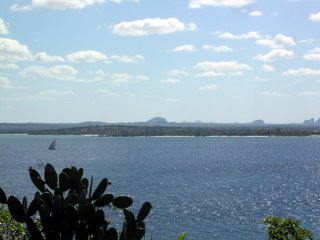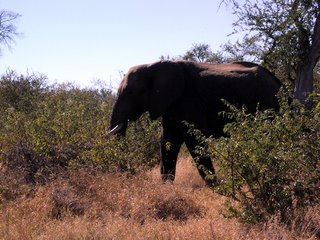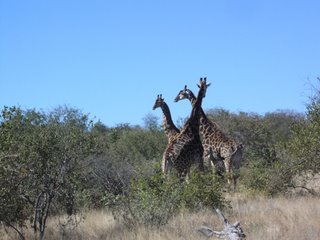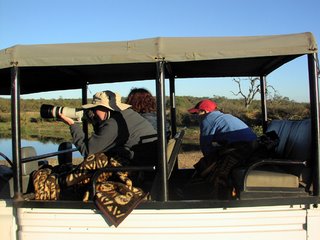Sunday, July 16, 2006
Renée's thoughts
Hello All,
This turned out longer than I thought it would, so if you don’t want to read it all, don’t worry – I will never know!
Well, I know I promised to write something about our trip a few days ago, but what with one thing and another – mostly another, called WORK! – I didn’t get around to it until today. Luckily for me, Paul and Eli (actually I think it was Paul J) managed to write something on their blog (http://peacecorpsmoz.blogspot.com/) before I wrote my bit, so I have just copied it below and now all I have to do is write my comments on the trip. That was fortuitous, was it not? J
So where to begin? When we used to travel as a family with the kids, we started a sort of tradition of saying at the end of each trip, what the best and worst of the trip was. So maybe I will just continue that tradition here.
Certainly, the best part of the trip for me was seeing Elisabeth and Paul and seeing that they were happy and well in their life together in Mozambique
Besides teaching well, they seem to have adapted well to the Nacala life style, with all the cultural differences that I am sure have caused them some degree of frustration. They seem to take bucket baths in their stride (Is this my daughter, who used to use her 15-minute morning hot shower the way I use coffee to wake up every morning?!) and can bargain with the best of the door-to-door fruit and shrimp vendors to get a good price. Every time we went out, people would call out “salaama” (sp?) to them (actually more to Paul – remember this is a male-dominated society, at least in public). The whole city seemed to know them – and by extension, us – and I got the impression that they were liked and respected. It was great to meet their friends in the market and we were made to feel very welcome.
In general, the people we met were very friendly to us. Their students were shy but very interested in speaking to us, and they asked us all sorts of questions about ourselves and our life in Europe . They all wanted to go to Europe or the US Mozambique
A few times, we visited the homes of students or friends, and they always treated us as if we were honored guests. For example, most of the people do not sit on chairs; they sit on mats (made of straw or rattan or something similar – I am not sure what the material is). But when we went to visit, they always brought out chairs for us to sit on. And once we went to visit a friend of theirs (Raimundo – he is in the photos), and he sent his daughter to the store to buy Cokes and Fantas for us (though I am sure he could ill afford it) and he put out French fries and pieces of bread (we figured that was all he had) for us to snack on. So you can see that although they may not have much, they shared what they had. We actually felt kind of bad about eating and drinking this when we knew that it was difficult for him to provide it, but there was clearly no way we could refuse.
Another interesting part about these visits was that it was always the man of the family who “entertained” us. At some point, he called over his wife and children to introduce them, but they never said anything – they just sat on the side without participating in the conversation unless they were invited to do so by the man.
Most of the people we met were native Mozambicans, but we also met a family (Abdul in the photos) who is from Mozambique Mozambique South Africa Mozambique
The scenery in Mozambique Mozambique Europe or the US
If you have managed to stay with me this far, you may be wondering if there were no negative points. Don’t worry, there were. This is still a poor, third-world country trying hard – against many odds – to develop its economy and social structure. If you have never traveled in one of these countries before, it can be quite a shock to your system. Fortunately, I had had experience (albeit many years ago – somewhere around the time of the dinosaurs, as my kids would say) and I can say that I was not shocked by any of it and thoroughly enjoyed the entire trip! (In fact, I think I bored Paul and Elisabeth out of their brains at times with remembrances of my travels that were sparked by similar situations we experienced in Moz.
Having said all this, I have to say that the whole experience is more than worth the inconveniences I have just mentioned. The people are wonderful, the scenery is fantastic, and I hope to go back next year.
Paul has pretty much said all there is to say about the safaris and South Africa
The other thing I noticed about South Africa Mozambique
I hope you enjoyed this LONG commentary. I could probably write a lot more – this was really a wonderful trip, and I am so happy that Paul and Elisabeth were able to put up with us for so long.
Love,
Renée
Saturday, July 15, 2006
nossa visita
Another day we took them to the market where we spent the afternoon introducing them to all of our market vendor friends. We also had lunch at the market, where the food is a little more traditional than what our empregada cooks for us. We made trips to the Fernao Veloso beach that´s near our house and to the Bay Diving tourist camp where we tried to snorkel and dive, and even though we paid for all the snorkel equipment we really did neither because it was too windy that day. But we had a good lunch, they met our missionary friends, and also we got some great views of the bay.
To get a more Mozambican experience we also went on a walk through the bairos, or neighborhoods, which are mostly mud houses built on a rock hill. They are much more reflective of how most Mozambicans live- they are relatively few areas like where we live in the country. Most apartment buildings like ours were built by the Portuguese and are fairly rare.
After about a week we rented a chapa again and went to Chocas beach, which is a very famous and pretty beach, about 75 Km away. It was our first time there as well, because it´s hard to get to with out a private car. Unfortunately it rained when we got there! And it hadn´t rained in our area in almost 2 months! Very strange. We didn´t spend much time there because of the rain and continued on to Ilha de Mozambique, which is a world heritage site and more touristy.
Although it was still raining off and on, we had a good time walking around, visiting the old Portuguese fortress and eating at some nice restaurants. The city is slowly being rehabilitated, and looks better every time we go (they are redoing some of the old Portuguese architecture, redoing railings and mosaics on the ground). The island has a lot of history and was the original capital of the country. Also, the island is tiny so we managed to spend just 1 night there and still managed to see a lot of it.
The visit to Nacala was pretty brief, but after our trip to Ilha we all flew down to Maputo, then caught a bus to South Africa, to go on a safari in Kruger park! We were picked up in Nelspruit for the safari and driven to a private game reserve that is adjacent to Kruger park and has no boundaries or fences between it and the park, so all the kruger animals are free to come in. On the safari we stayed in a bush camp in the middle of a 60 thousand hectare reserve. There were only 11 tourists in that area, and the four of us got our own guide, so during the animal viewing part of the safari it was just us. In the camp we stayed in large tents that had real beds and a fairly weak light if we needed it, it also had hot showers and flushing toilets which were solar powered. There was a kitchen and pavilion to eat in, and it was very comfortable. We were right in there with the animals and the guides warned us not to wander out of camp. During the night baboons would poop on our tent, and we could wake up to find hyena and hippo tracks not far from our camp at all!
On a usual day of the safari we would wake up before dawn, and have a quick breakfast of hot chocolate and cereal, then go on a walk or drive just as the sun came up. Sometimes we would drive out a short ways in the open land rover, then walk. Our guide tried to track the animals and would point out their prints to us. He also carried a gun in case something ran into us! The morning walk was about 4 hours, then we would go back to camp and have a full breakfast. Then we relaxed for a bit, had a big lunch at 3pm, and went on another walk drive. This lasted for about 3.5 hours, and when the sun went down we would have drinks then take a night drive. A night drive consists of riding around in the cold, while the guide tries to spot animals by blinding them with a spotlight. For the most part we didn’t see much on the night drives, although once we did see a hyena crossing the road or a herd of buffalo another time.
When we got back we had a big dinner, sat around the campfire, then went to bed.
The one important thing is that it was FREEZING THERE! We had to wear 3 layers at morning and night, although you could usually get to shorts and shirt during mid day. Eli and I had to sleep with hot water bottles at night! We´ve never had a day of cold weather in Nacala and weren’t prepared for it at all in South Africa!
In terms of animals, we saw a lot, but because it´s a walking safari and thus we´re not covering as much ground, we didn´t see all of the big 5, and sometimes we went whole walks with out seeing any major mammals. I say mammals because we did see lots of birds, but nobody seemed to really care about that but me. I had my bird book and a good pair of binoculars so I was happy. In fact, after the safari the guide gave me one of his bird guide books. We did see an elephant up close, which was great. We had spotted him and tried tracking him on foot, and got pretty close, but we had to turn back because the elephant was in deep bush which I guess can be a little dangerous. So we took our land rover and intercepted him in the road. He passed right in front of our car and took his time, so we got a good view.
We tried tracking a rhino but we never found him. We also didn´t see any lions or leopards on the walking safari. We did see a lot of giraffe and zebra, hords of impala, a lot of buffalo and a hippo as well as some warthogs.
After the walking safari we rented a car and went into the actual Kruger park, which has paved roads, and you´re not actually allowed to get out of your car. But in the actual park there are lots of animals, and many of them aren´t afraid of your car, so we did see a LOT of animals. We saw 2 different prides of lions, although mostly they were laying in the grass so you had to wait for them to get up and move to get a good view, but once we saw the male lion with his big shaggy mane get up and walk around, which was cool. One of the times there was a really big group of cars near the lions, all pushing to get as close as possible, and even some people hanging out of their car windows trying to get pictures. It was ridiculous! One of the best parts of the walking tour was the complete absence of other tourists.
We saw more elephants and giraffe in Kruger park as well. Some of the best viewing came when we pulled up to a small water hole which was full of hippos, some of which were playing in the water near our car, and others which were standing on the far shore. The banks were lined with crocodiles, and there were a bunch of big birds in the water.
There are little rest stops in Kruger park where you can get out of your car and buy some food, and look out over the river for animals. We stopped once to stretch and get a bite, we bought some waffles and Renee bought herself a cookie. Before she even got a chance to eat the cookie she was charged by a giant baboon! Thinking that it wanted to cookie she threw it at him, but he wasn´t interested in the cookie and kept running at her. Apparently the baboon had been a problem and someone was ready to smack it with a big stick. People were talking about how the rangers would have to come out and shoot it because it had become too aggressive. Just before we left we watched it run up to someone else and grab a whole loaf of bread and then run away. Baboons are fairly large and have pretty big teeth, so usually you just let it take what it wants!
The only problem with our trip to Kruger park is that we hadn´t booked a camp site inside the park, hoping to just get one when we showed up. Unfortunately they were completely full, so we had to stay in a hotel outside of the park. It actually worked out kind of well for us because the first hotel we went to was the Protea Kruger Gate hotel, which is an incredibly fancy 4 star hotel. It´s by far the nicest hotel I´ve ever been to. It´s also very expensive but the receptionist took pity on us and counted Eli and I as children, and gave us a discount for a group that we weren’t members of, and so we all got to stay in one room at about half the normal price. We also ate a really wonderful dinner for free, partly because Renee and Lyn´s meal was free with the room, and then they forgot to charge Eli and me.
After our 2 days driving around Kruger Eli´s parents went to Jo burg to fly back to Spain and we stayed in Nelspruit then caught a bus back to Maputo. We had been planning on traveling around the south of Mozambique a bit so we had bought our plane tickets for 4 days after we got back to Maputo. But we were feeling tired, and also feeling bad about missing school, so we tried to change our plane tickets to leave right away. Unfortunately all the flights for the week were full, and we didn´t feel like traveling, so we just stayed in Maputo in a nice hotel and hung out with the other peace corps volunteers who are always in Maputo for one reason or another. (We always stay at the same hotel too, where we get a nice discount). The first time we ever saw Maputo we were shocked by how poor it looked, but this time we really felt that we were in New York, it had soo much compared to what we´re used to!
Anyways, we flew back to Nacala just in time for the last week of school, which gave us time to get our grades sorted out, and then we had Conselho de Nota, which is where we actually write out all of the grades. It is a HORRIBLE process where I probably copy out about 5000 grades into various places. Not only do you copy grades for every student in every discipline into 4 locations, but you do it first in pencil and then again in pen, and when you have 90 students with 6 disciplines… it takes about 3 days. Tomorrow is the last day of that. Then next week we have to proctor national exams.
I have my camera now and I´m trying to send out some pictures. I had emailed some out, but if anyone has a good suggestion on how or where to post my digital pix, I´d appreciate it. I would prefer something where I don´t have to send people an email link in order for them to be able to see the pix.
Hope everything is good back home!
Love,
Paul and Eli
Wednesday, July 12, 2006
pictures of our trip
Anyway, here are the links for the photos:
Hope you enjoy them.
Renée
Monday, July 10, 2006
Back from the Bush!
Unfortunately Eli and I have a lot of school work to make up- it´s almost the end of the 2nd trimester and we´ve got to finish grading- so today I won´t do the full report of the last 3 weeks. But I do have some good pictures to give you a taste of what we´ve been up to! Enjoy, and I´ll be putting up a lot more pix in the near future! (As soon as time permits!)
Eli, Renée and Lyn in the Jeep (actually land rover or some such) taking some pix of the animals. We usually traveled a little ways in the jeep before starting on our walks. It´s also a great way to see the animals because you can get a good view with the lack of windows or doors to get in the way!
This is the bay of Nacala! As seen from Bay Diving the touristy resort that´s near our house. Of course we don´t get out here that often, but we are right on the bay (just farther down).
Eli and her mom on Ilha de Mozambique. You can tell it´s cold because Eli has wrapped herself up in a capulana! We spent the night on the ilha and had a really good time! Unfortunately it also rained on that trip, after almost 2 months with out ANY rain!! Weird!

Safari Pictures! We saw a lot of animals, and especially on the walking safari we got to be fairly close to some of them. Lyn had the best camera and took the most pix, hopefully I´ll get a CD of them sometime soon and then we´ll see some nice animal close ups! (He had a 400mm zoom lense!)


